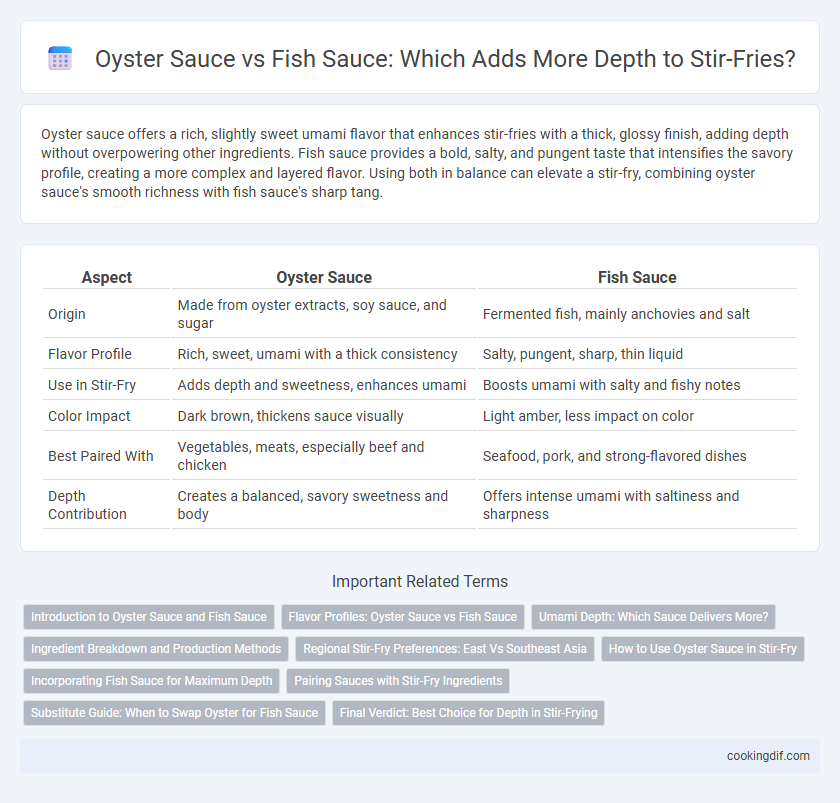Oyster sauce offers a rich, slightly sweet umami flavor that enhances stir-fries with a thick, glossy finish, adding depth without overpowering other ingredients. Fish sauce provides a bold, salty, and pungent taste that intensifies the savory profile, creating a more complex and layered flavor. Using both in balance can elevate a stir-fry, combining oyster sauce's smooth richness with fish sauce's sharp tang.
Table of Comparison
| Aspect | Oyster Sauce | Fish Sauce |
|---|---|---|
| Origin | Made from oyster extracts, soy sauce, and sugar | Fermented fish, mainly anchovies and salt |
| Flavor Profile | Rich, sweet, umami with a thick consistency | Salty, pungent, sharp, thin liquid |
| Use in Stir-Fry | Adds depth and sweetness, enhances umami | Boosts umami with salty and fishy notes |
| Color Impact | Dark brown, thickens sauce visually | Light amber, less impact on color |
| Best Paired With | Vegetables, meats, especially beef and chicken | Seafood, pork, and strong-flavored dishes |
| Depth Contribution | Creates a balanced, savory sweetness and body | Offers intense umami with saltiness and sharpness |
Introduction to Oyster Sauce and Fish Sauce
Oyster sauce offers a rich, savory umami flavor with a slightly sweet and thick consistency, making it ideal for enhancing the depth of stir-fry dishes. Fish sauce delivers a potent, salty, and fermented taste, providing a sharp, briny complexity that intensifies the flavors in Southeast Asian stir-fries. Both sauces are essential condiments that bring distinct layers of flavor and depth, with oyster sauce contributing mellow sweetness and fish sauce offering bold saltiness.
Flavor Profiles: Oyster Sauce vs Fish Sauce
Oyster sauce offers a rich, slightly sweet, and savory flavor with a thick texture that enhances stir-fry dishes by adding umami depth and a glossy finish. Fish sauce provides a strong, salty, and pungent taste derived from fermented fish, delivering an intense umami punch that brightens savory dishes. Choosing oyster sauce creates a balanced, mellow flavor profile while fish sauce intensifies boldness and complexity in stir-fry recipes.
Umami Depth: Which Sauce Delivers More?
Oyster sauce provides a richer, slightly sweet umami depth with a thicker texture, enhancing stir-fry dishes with a complex, savory flavor profile. Fish sauce offers a sharper, saltier umami punch, delivering intense and aromatic notes that penetrate ingredients deeply. For maximum umami depth in stir-fry, oyster sauce is preferred for layering subtle sweetness, while fish sauce excels in bold, pronounced savoriness.
Ingredient Breakdown and Production Methods
Oyster sauce is crafted by reducing oyster extracts with sugar, salt, and cornstarch, resulting in a thick, slightly sweet, and savory condiment that provides umami depth without overpowering dishes. Fish sauce is produced through the fermentation of anchovies and salt over several months, yielding a thin, intensely salty liquid with a pungent aroma that imparts a bold, salty umami flavor. The differences in ingredient breakdown and production methods make oyster sauce ideal for adding a rich, mellow sweetness, while fish sauce delivers a sharper, more pronounced marine character in stir-fry recipes.
Regional Stir-Fry Preferences: East Vs Southeast Asia
Oyster sauce delivers a rich, slightly sweet umami depth favored in East Asian stir-fries, especially within Chinese cuisine, enhancing savory notes without overpowering. Fish sauce, with its pungent, salty, and complex aroma, is integral to Southeast Asian stir-fries, such as Thai and Vietnamese dishes, providing a distinctive fermented seafood flavor that intensifies regional profiles. Both sauces define the unique taste architecture of their respective culinary traditions, shaping the regional stir-fry preferences in East versus Southeast Asia.
How to Use Oyster Sauce in Stir-Fry
Oyster sauce adds a rich, savory umami depth to stir-fry dishes, enhancing the overall flavor with its slightly sweet and thick texture. To use oyster sauce in stir-fry, add it towards the end of cooking to coat the vegetables and protein evenly, ensuring it doesn't burn and maintains its glossy finish. Combining oyster sauce with soy sauce or a splash of fish sauce can create a well-rounded taste, balancing saltiness and sweetness for a complex flavor profile.
Incorporating Fish Sauce for Maximum Depth
Incorporating fish sauce into stir-fry dishes enhances umami depth and complexity more effectively than oyster sauce, thanks to its fermented anchovy base rich in amino acids. Fish sauce delivers a savory, slightly salty flavor that intensifies the natural taste of vegetables and proteins without overpowering the dish. Using fish sauce in moderation like 1-2 teaspoons per serving ensures a balanced, nuanced depth that elevates the overall stir-fry experience.
Pairing Sauces with Stir-Fry Ingredients
Oyster sauce imparts a rich, slightly sweet umami flavor that enhances the savory profile of stir-fried vegetables, beef, and chicken, providing depth without overwhelming the dish. Fish sauce delivers a more pungent, salty, and complex aroma ideal for seafood stir-fries, balancing bold flavors like garlic, chili, and herbs. Pair oyster sauce with mushrooms, bok choy, or beef for a mellow richness, while fish sauce pairs best with shrimp, morning glory, and intense aromatics to elevate the overall taste complexity.
Substitute Guide: When to Swap Oyster for Fish Sauce
Oyster sauce offers a rich, slightly sweet umami depth ideal for enhancing stir-fry's savory profile, while fish sauce provides a saltier, more pungent flavor with a distinct marine tang. Substitute oyster sauce with fish sauce when aiming for a lighter texture and sharper, salt-forward punch, adjusting quantities carefully to prevent overpowering the dish. Fish sauce is perfect for Southeast Asian-inspired stir-fries, whereas oyster sauce excels in Chinese-style recipes needing a thick, glossy finish.
Final Verdict: Best Choice for Depth in Stir-Frying
Oyster sauce delivers a richer, slightly sweet umami depth ideal for enhancing stir-fry dishes, while fish sauce offers a sharper, saltier flavor with marine undertones. For a balanced, deeply savory profile that complements vegetables and proteins alike, oyster sauce is typically the preferred choice. Fish sauce works best when aiming for a bold, pungent kick but can overpower subtle stir-fry ingredients if used excessively.
Oyster sauce vs fish sauce for depth Infographic

 cookingdif.com
cookingdif.com